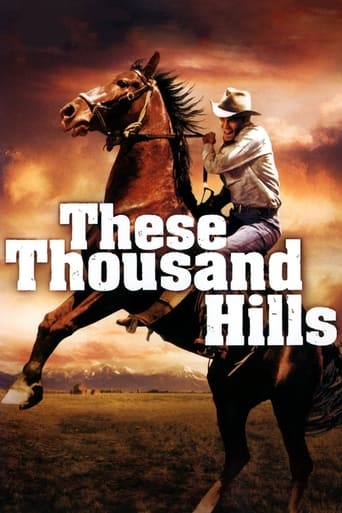

A western about a cowboy who rises up the social ladder to become a respected rancher and later a Montana politician, who seems to become more of a hypocrite with each step up. Don Murray, who plays the lead role, dumps Lee Remick as a saloon girl for Patricia Owens who plays the wholesome daughter of one of the town's prominent leaders. Dumping Remick for Owens seems to signify Murray's embrace of and acceptance into the town's Christian and social establishment, and his abandonment of his cowboy social outcast pal played by Stuart Whitman. Richard Egan occupies the film's bad guy role as Remick's abusive ex-boyfriend, and unscrupulous rancher. A classic example of a 1950s western with modern themes set amongst the beauty of the old West.
... View MoreThese Thousand Hills casts Don Murray as a young cowboy who arrives in Montana broke but with an idea. Rather than have cattle feed on the open range in winter left to the elements, he wants to grow and store hay for winter feed. In order to do this he romances two women, banker's niece Patricia Owens and saloon girl Lee Remick. Murray's both a hard worker and a fast worker.This film highlights a growing trend in the Fifties toward adult westerns. They wouldn't yet show it on television, but that Lee Remick is a prostitute is not left to any imagination. In fact even though Remick gave Murray the seed money for his ranch, Murray then objects to pal Stuart Whitman marrying one in Remick's friend Jean Willes.And Murray's attentions to Remick among other things have made him a bad enemy in saloon owner Richard Egan. Basically you have all the ingredients of the story of These Thousand Hills.The film really belongs to both Murray and Lee Remick who gives quite a portrayal of a battered woman, again most unusual for any picture in the Fifties let alone a western.As entertainment the film still holds up well today, but I'd keep it from the littlest ones.
... View MoreTerrific production values. Great cast. Lackluster script. Terrible soundtrack. Something missing. Too clean and tidy. Not realistic in a strange sense. A melodrama western? Not a bad film just not a really good one and certainly not as good as it should have been given the great cast. Lots and lots of clichés. Main character is not really likable. Many loose ends. Underdeveloped characters. Worth watching for Lee Remick and Patricia Owens.I can't put my finger quite on the reason why this film falls flat. There just isn't any sizzle or scenes that grab you. Perhaps it is because the role of Latt (the main character) is not sympathetic. He seems to change from a decent guy to a heel almost overnight, forgetting about his true friends. Then he redeems himself instantly at the end. People don't change back and forth and back again like that.
... View MoreThis is the story of a cowboy Lat Evans (Don Murray) driven by blind ambition who is not fair to the woman who loves him and helped him (Lee Remick) and his best friend who saved his life (Stuart Whitman). Richard Egan has a good performance as the villain, who is also after Remick but treats her badly. Murray's attitude in relation to Remick and Whitman is so cruel and shocking that even when he tries to redeem himself you are not convinced that he has suffered enough. When the film starts you look at Murray like a standard western hero, and the fact that when the film ends it still tries to make you believe Murray is a good guy who paid for his sins, leaves the spectator with a feeling something is missing. I liked the film, but did not like the ending.
... View More